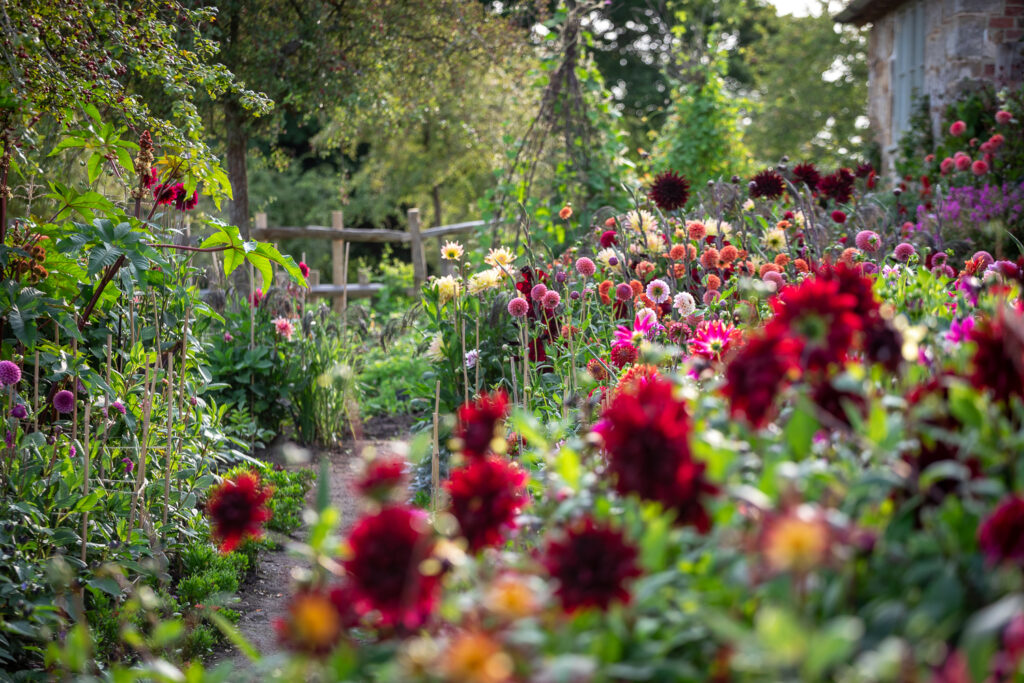Top tips from Sarah Raven for the most delightful dahlias

All photographs © Jonathan Buckley
Dahlias are the backbone of any garden, flowering from July up to the first frost in November. Boasting sumptuous textures, impressive scale, and unrivalled scent, they are perfect for making any outdoor space come alive with colour.
From luscious red and purple dahlias to creamy pastel pinks and oranges, there’s something to suit the tastes of every dahlia grower. Dahlias are some of the lowest maintenance, highest production cut flowers and garden plants you can grow. So follow the guidance – shared by gardening expert Sarah Raven, get potting and look forward to a summer of blooms!
In this video, Sarah explains her deep love dahlias. The perfect way to elevate borders, pots, and containers
At Sarah’s Perch Hill Garden in East Sussex, they grow hundreds and hundreds of dahlias. Excellent cut for a vase, each dahlia tuber can produce bountiful flowers, meaning a colourful show inside and out for weeks on end. They come in all different sizes and colours, each as exciting as the next, but they also come in myriad shapes.
- The dahlia bed at Perch Hill at dawn. Dahlia ‘Perch Hill’ and ‘Bishop of Auckland’ with dill
- Bunch of Sarah Raven exclusive dahlias. Dahlia ‘Perch Hill’, ‘Sarah Raven’, ‘Josie’ and ‘Molly Raven’
Top tips for potting up dahlia tubers
Dahlia tubers can be started off in March or April in pots undercover, and then planted out in the garden in late May and June.
Begin by half-filling a 2 or 3 litre pot with peat-free multi-purpose compost. Place the tuber in the pot with the central stem upwards and cover with more compost. Don’t forget to label each variety and lightly water the pot, then place it somewhere warm and frost-free – a greenhouse is ideal. Don’t water again until they start to shoot, and even then, only water lightly. Over watering can cause rot to set in, which will damage your tubers.
After 2-3 weeks, green shoots will start appearing. Some varieties may take a little longer, so be patient. As these shoots grow, pinch out the tips of the main shoot (you can use a sharp knife or squeeze between your thumb and forefinger), down to the top pair of leaves.
As the plant continues to grow, remove all but five shoots sprouting from the tuber. Although this might feel a little harsh, having only five stems will allow each stem to develop and strengthen, and result in abundant and beautiful flowers!
Top tips for planting dahlia tubers in the ground
If you don’t have space to plant the tubers in pots first, you can put them straight into the ground in spring – just make sure the frosts are over.
Plant the tubers just under the soil surface and ensure they are approximately 75cm (30in) apart, depending on the variety.
Insert a stout stick to act as a stake when planting as they are sizeable plants when fully grown. Mulch over the top of them or protect them with a cloche or hortiwool. This is particularly important if the foliage appears before the frosts are over.
Whether you have raised your dahlia tubers outside in the garden or undercover, you need to pinch out the tips of the main shoot once three pairs of leaves have grown. Use a sharp knife or squeeze between your thumb and forefinger and pinch out down to the top pair of leaves.
For more top tips and helpful information on how to plant, grow & care for dahlias, visit: https://www.sarahraven.com/articles/how-to-plant-and-grow-dahlias
- Dahlia trial garden at Perch Hill
- The dahlia trial bed in the perennial cutting with Phlox in the foreground. Dahlias include the Jelly Tots dahlia collection. Includes Dahlia ‘Wittemans Superba’, ‘Cryfield Harmony’, ‘American Sunset’ and ‘Erpeler Ley’
A new partnership
We are delighted to be partnering with gardening expert, Sarah Raven in 2023. They will be helping to encourage individuals who are passionate about their gardens, to open in aid of the National Garden Scheme and to raise funds for vital nursing and health charities. You can read more about the partnership here.






















